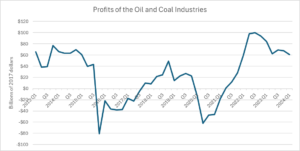Is Drill Everywhere Good for the Oil Companies?
The Trump campaign has made “drill everywhere” one of its main campaign slogans, implying that it will radically weaken environmental and other restrictions on oil drilling. This is supposed to be good for both the economy, since it would in principle mean lower gas and energy prices more generally, but also the oil industry since it won’t have to worry about government regulations in deciding where and how to drill. Increased oil production would be bad news for the environment since it likely means more local contamination, but more importantly, it will increase greenhouse gas emissions which will accelerate global warming.
The bizarre aspect to this story is that somehow lower oil prices is supposed to be a good thing for the oil industry. Predicting oil prices is not an easy thing to do, and as a practical matter the U.S. is already producing oil at record levels, so “drill everywhere” may not mean much additional oil production. But if the campaign’s promise comes true, and oil prices do fall sharply, that is not likely to be good news for the industry.
The figure below shows the combined profits for the oil and coal industry (the bulk of this oil) since 2013. The numbers are in 2017 dollars, so they are adjusted for inflation.

Source: NIPA Table 6.16D, Line 25.
As can be seen, profits fell from over $60 billion in 2014 to massive losses in 2016 and 2017. Profits recovered modestly in 2018 and 2019 but were still less than half the levels of 2014. The industry again took large losses with the pandemic shutdowns in 2020. Profits recovered in 2021, soaring to record highs in 2022 following Russia’s invasion of Ukraine. In more recent quarters profits have fallen back to roughly their 2014 levels.
This pattern closely tracks oil prices. Oil was selling for over $100 a barrel at the start of 2014. Prices fell sharply in the second half of the year, bottoming out at $44 a barrel in the middle of 2015. After briefly leveling off, they plunged again at the end of the year, bottoming out at less than $30 a barrel in early 2016. Prices then edged up staying mostly over $60 a barrel until the pandemic hit.
The pandemic shutdowns sent prices to record lows. They then recovered with the economy, before soaring to peaks of more than $120 a barrel following the invasion of Ukraine. Prices have since fallen back to the $70-$80 a barrel range, which is comparable to pre-pandemic prices after adjusting for inflation.
Again, the future path of oil prices is not easy to predict, but there does seem a contradiction between the idea that allowing the industry to drill everywhere will both be a profits bonanza and also mean cheap gas for consumers. If a large increase in U.S. production does send oil prices sharply lower, the oil industry is not likely to be very happy.
This first appeared on Dean Baker’s Beat the Press blog.
No comments:
Post a Comment